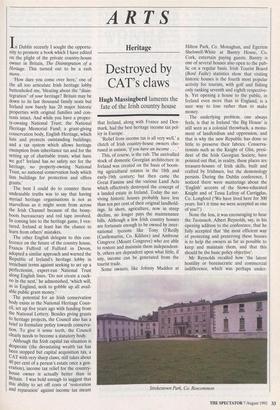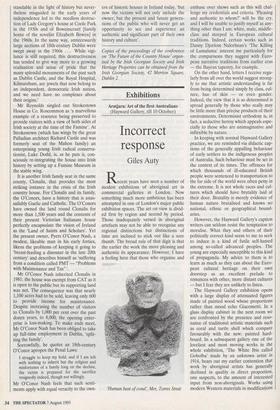ARTS
Heritage
Destroyed by
CAT's claws
Hugh Massingberd laments the fate of the Irish country house Iri Dublin recently I sought the opportu- nity to promote a book which I have edited on the plight of the private country-house owner in Britain, The Disintegration of a Heritage. This turned out to be a rash move.
`How dare you come over here,' one of the all too articulate Irish heritage lobby buttonholed me, 'bleating about the "disin- tegration" of your heritage? Britain may be down to its last thousand family seats but Ireland now barely has 20 major historic properties with original families and con- tents intact. And while you have a proper- ty-owning National Trust; the National Heritage Memorial Fund; a grant-giving conservation body, English Heritage, which lists and protects outstanding buildings; and a tax system which allows heritage exemption from inheritance tax and for the setting up of charitable trusts, what have we got? Ireland has no safety net for the heritage, no property-owning National Trust, no national conservation body which lists buildings for protection and offers grants.'
The best I could do to counter these undeniable truths was to say that having myriad heritage organisations is not as marvellous as it might seem from across the Irish Channel because of the bossy- boots bureaucracy and red tape involved. In coming late to the heritage game, I ven- tured, Ireland at least has the chance to learn from others' mistakes.
The other English delegate to this con- ference on the future of the country house, Francis Fulford of Fulford in Devon, adopted a similar approach and warned the Republic of Ireland's heritage lobby in trenchant terms against seeking to set up a perfectionist, expert-run National Trust along English lines. `Do not create a cuck- oo in the nest,' he admonished, 'which will, as in England, seek to gobble up all avail- able public grant money.'
The potential for an Irish conservation body exists in the National Heritage Coun- cil, set up five years ago with funding from the National Lottery. Besides giving grants to heritage projects, the Council also has a brief to formulate policy towards conserva- tion. To give it some teeth, the Council clearly needs to become a statutory body.
Although the Irish capital tax situation is desperate (the devastating wealth tax has been stopped but capital acquisition tax, a CAT with very sharp claws, still takes about 40 per cent of a person's estate once a gen- eration), income tax relief for the country- house owner is actually better than in Britain. I was bold enough to suggest that this ability to set off costs of 'restoration and reparation' against income tax meant that Ireland, along with France and Den- mark, had the best heritage income tax pol- icy in Europe. 'Relief from income tax is all very well,' a clutch of Irish country-house owners cho- rused in unison, 'if you have an income . . .
This, of course, is the rub. The unrivalled stock of domestic Georgian architecture in Ireland was created on the basis of boom- ing agricultural estates in the 18th and early-19th century; but then came the Great Famine and the various Land Acts which effectively destroyed the concept of a landed estate in Ireland. Today the sur- viving historic houses probably have less than ten per cent of their original landhold- ings. In short, agriculture, now in steep decline, no longer pays the maintenance bills. Although a few Irish country houses are fortunate enough to be owned by inter- national tycoons like Tony O'Reilly (Castlemartin, Co. Kildare) and Ambrose Congreve (Mount Congreve) who are able to restore and maintain them independent- ly, others are dependent upon what little, if any, income can be generated from the tourist trade.
Some owners, like Johnny Madden at Hilton Park, Co. Monaghan, and Egerton Shelswell-White at Bantry House, Co. Cork, entertain paying guests. Bantry is one of several houses also open to the pub- lic on a regular basis. Irish Tourist Board (Bard Failte) statistics show that visiting historic houses is the fourth most popular activity for tourists, with golf and fishing only ranking seventh and eighth respective- ly. Yet opening a house to the public, in Ireland even more than in England, is a sure way to lose rather than to make money.
The underlying problem, one always feels, is that in Ireland 'the Big House' is still seen as a colonial throwback, a monu- ment of landlordism and oppression, and that is why the new Republic has done so little to preserve their fabrics. Conserva- tionists such as the Knight of Glin, presi- dent of the Irish Georgian Society, have pointed out that, in reality, these places are treasure-houses of Irish skills, built and crafted by Irishmen, but the demonology persists. During the Dublin conference, I noticed there were mutterings about the `English' accents of the Stowe-educated Knight and of Tessa Lefroy of Carrigglas, Co. Longford ('We have lived here for 300 years. Isn't it time we were accepted as one of you?') None the less, it was encouraging to hear the Taoiseach, Albert Reynolds, say, in his opening address to the conference, that he fully accepted that 'the most efficient way of protecting and preserving these houses is to help the owners as far as possible to keep and maintain them, and that this should be the basic policy objective'.
Mr Reynolds recalled how 'the latent hostility or bureaucratic and commercial indifference, which was perhaps under- Strokestown Park, Co. Roscommon standable in the light of history but never- theless misguided in the early years of independence led to the needless destruc- tion of Lady Gregory's house at Coole Park in the 1930s and of Bowenscourt [family home of the novelist Elizabeth Bowen] in the 1960s. In the same way, unnecessarily large sections of 18th-century Dublin were swept away in the 1960s . . . While vigi- lance is still required, this destructiveness has tended to give way more to a growing realisation and sense of pride that the many splendid monuments of the past such as Dublin Castle, and the Royal Hospital, Kilmainham, are jewels that now belong to an independent, democratic Irish nation, and we need have no complexes about their origins.'
Mr Reynolds singled out Strokestown House in Co. Roscommon as 'a marvellous example of a resource being preserved to provide visitors with a view of both sides of Irish society at the time of the Famine'. At Strokestown (which has wings by the great Palladian architect Richard Castle and was formerly seat of the Mahon family) an enterprising young Irish radical conserva- tionist, Luke Dodd, is, as he puts it, con- sciously re-integrating the house into Irish history by setting up a Famine Museum in the stable wing.
It is another Irish family seat in the same county, Clonalis, that provides the most striking instance in the crisis of the Irish country house. For Clonalis and its family, the O'Conors, have a history that is unas- sailably Gaelic and Catholic. The O'Conors have owned the land round Clonalis for more than 1,500 years and the contents of their present Victorian Italianate house perfectly encapsulate the vision of Ireland as the 'Land of Saints and Scholars'. Yet the present owner, Pyers O'Conor Nash, a modest, likeable man in his early forties, likens the problems of keeping it going to `breast-feeding a dinosaur in the late 20th century' and describes himself as 'suffering from a condition called PMT — "Problems with Maintenance and Tax" '.
Mr O'Conor Nash inherited Clonalis in 1981: the house was exempt from CAT as it is open to the public but its supporting land was not. The consequence was that nearly 1,100 acres had to be sold, leaving only 600 to provide income for maintenance. Despite increasing the number of visitors to Clonalis by 1,000 per cent over the past dozen years, to 8,000, the opening enter- prise is loss-making. To make ends meet, Mr O'Conor Nash has been obliged to take up full-time employment in Dublin, 'split- ting the family'.
Sorrowfully, he quotes an 18th-century O'Conor apropos the Penal Laws: I struggle to keep my hold, and if I am left with nothing to inherit but the religion and misfortunes of a family long on the decline, the victim is prepared for the sacrifice resignedly indeed, though not willingly.
Mr O'Conor Nash feels that such senti- ments apply with equal veracity to the own- ers of historic houses in Ireland today, 'but now the victims will not only include the owner, but the present and future genera- tions of the public who will never get an opportunity to see and experience an authentic and significant part of their own history and culture'.
Copies of the proceedings of the conference on The Future of the Country House' organ- ised by the Irish Georgian Society and Irish Heritage Properties can be obtained from the Irish Georgian Society, 42 Merrion Square, Dublin 2.



















































 Previous page
Previous page